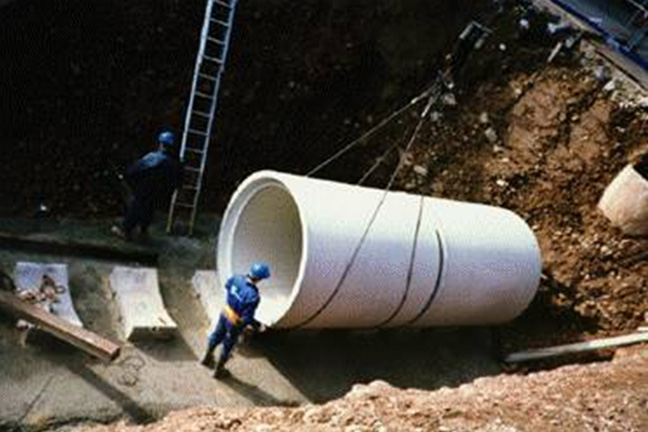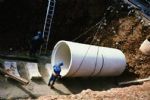Preparing the base of the trench
The slope and the material at the base of the trench must comply with the project specifications. The material at the base of the trench must not be altered. If it is modified, the bearing capacity stipulated originally must be preserved.
When the pipeline is laid at the base of the trench, this must be adapted to the slope and specific shape of the pipe, so that full support is ensured throughout the length of the pipes.
To achieve them a uniform grade line, fill the base of the trench, preferably with loose sand, gravel or crushed stone (smaller than 20 mm), and compact it to avoid it settling differently.
If you have an inconsistent layer of earth in the base of the trench, the standard UNE-EN 1610 indicates that you must remove it and replace it with a suitable material. If you find significant volumes you must reevaluate the structural design.
This filling must be carefully it is packed in layers and the surface made uniform. If the base of the trench it is filled with sand or gravel, when the type of pipe requires it, carry out the filling and make niches for this piping.
The pipes shall not rest directly on the grade line of the trench, but rather on beds.
The specifications of these beds will depend on the soil, the dimensions of the pipes and the type of pipe used.
When low temperatures require it, it is necessary to protect the base of the trench so that the frozen layers are not under or next to the pipes.
The General Technical Specifications for Urban Wastewater Piping from the Spanish Ministry of Development classifies terrain into the three following qualities:
 Stable: Consolidated terrain, with guaranteed stability. This type of filling includes, rocky, transit, compact and similar.
Stable: Consolidated terrain, with guaranteed stability. This type of filling includes, rocky, transit, compact and similar.- Stable: Consolidated terrain, with guaranteed stability. This type of filling includes, rocky, transit, compact and similar.
- Unstable: Terrain with possibility of localised expansion or settlement, which with suitable treatment can be corrected to meet similar specifications to stable terrain. This type of terrain includes, clay, filling and other similar materials.
- Exceptionally unstable: Terrain with a high possibility of settlement, slippage or other disturbances. This category includes mud, expansive clays, shifting ground and similar.
Consequently, with this classification and according to the specifications of the pipes, the gaskets and the terrain, the beds indicated in Table 6.3.7. are recommended. For bad terrain, and to prepare them before placing the bed, the special type of base recommended in each situation is indicated in the same table. When the terrain is very bad, the designer or site manager will study the most suitable solution in each specific case.
Table 6.3.7
| Pipe diameter | Type of gasket | Type of terrain | |||
| Good or stable | Bad or unstable | Very bad or exceptionally unstable (*) | |||
| Special base | Bed | ||||
| Up to 300
| Flexible | B-1-A | C-1-b | B-1-a | |
| Rigid | A-1-a | C-1-b | B-1-a | ||
| Up to 600 | Flexible | B-1-a | C-2-b | A-1-a | |
| Rigid | A-1-a | C-2-b | B-2-a | ||
| Up to 1,000 | Flexible | B-2-a | C-3-b | A-2-a | |
| Rigid | A-2-a | C-3-b | A-2-a | ||
| Up to 1,500 | Flexible | B-3-a | C-3-b | B-3-a | |
| Rigid | A-3-a | C-3-b | A-3-a | ||
| Up to 3,000 | Flexible | C-3-a | C-3-b | C-3-b | |
| Rigid | A-3-a | C-3-b | A-3-b | ||
| A: Concrete floor with 200 kg of cement/m3 B: Bed of sand with particle size measuring 2 to 5 mm, or gravel with size between 5 and 15 mm. C: Compacted gravel: (*) Exceptionally unstable terrain - exceptionally unstable terrain is treated suitably for each case. It is general practice to try to avoid it, even if this means increasing the budget. | |||||

Utilizamos cookies propias y de terceros, para realizar el análisis de la navegación de los usuarios. Si continúas navegando, consideramos que aceptas su uso.
Puedes cambiar la configuración u obtener más información aqui.

Arriandi auzoa, 1
48215 Iurreta (Bizkaia)
Tel.: +34 94... see telephone number
Fax: +34 94... see fax
Prefabricados Alberdi - Copyright 2012 | Legal notice | Data protection | Sitemap | Cookies
Website site designed 
and developed by DMacroweb




